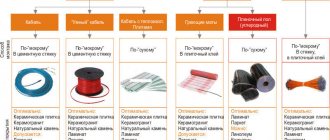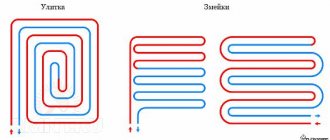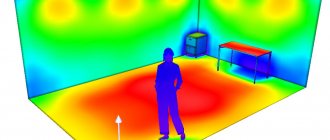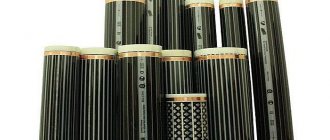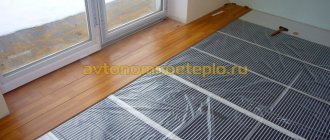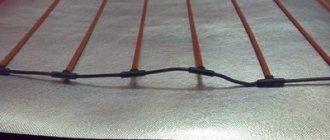- Calculation of heating mats and infrared film
- Heating cable calculation
- Calculation of UNIMAT core mat
Electric underfloor heating is represented by various types of systems: thin heating mat, heating cable, rod carbon mat, infrared film, each of which has its own range of characteristics and areas of application.
Price for heating mats under tiles from RUB 2,019.
The price for a heating cable in a screed starts from RUB 1,557.
Price for film IR heated floor from 609 RUR.
Price for rod-based infrared floor heating starts from RUB 3,158.
Proper selection and calculation of underfloor heating will ensure the most efficient functioning of the heating system with the lowest energy costs.
To make an accurate selection and calculation of a heated floor yourself, use the formulas described below or contact the specialists of the Warm Floor chain of stores in your city.
The choice of heated floors is based on the following data:
- The required degree of heating in a room or building. Electric underfloor heating can be used as a comfortable heating of the floor surface, as well as as the only source of heat in the apartment.
- The type of flooring used in the room. Each coating has different thermal conductivity and thermal sensitivity, which must be compatible with the heating system.
- Type of installation – cement screed (at the stage of major repairs); warm floor under tiles or dry installation under laminate (for cosmetic repairs).
- The total area of the room in which the heated floor will be installed, and the area not occupied by furniture.
Heating mat IQWATT from RUB 3,319.
IQWATT heating cable from RUB 3,076.
Film flooring CALEO from RUB 1,339.
UNIMAT rod floor from RUB 2,398.
Heating mat DEVI from RUB 4,261.
DEVI heating cable from RUB 4,307.
The first step to creating the optimal temperature using a “warm floor” system is to determine the required degree of heating: will comfortable heating of the floor surface be enough for you (the so-called “additional heating”) or is it necessary to compensate for the lack of central heating using a warm floor (main heating) . The answer to this question will determine the level of power that the “warm floor” system should have. For comfortable heating it is 100-150 W/m2; for main heating – 160-200 W/m2; for cold unheated rooms (balconies and loggias) – 200-250 W/m2.
It is important that the required power is compatible with the selected floor covering, the manufacturers of which, as a rule, indicate permissible temperature thresholds. Thus, for laminate and linoleum, the optimal power is 100-130 W/m2, the floor surface temperature should be in the range of 26-28 ° C. Therefore, these coatings are recommended to be used with heated floors only for additional heating. In most cases, KEEPLY infrared film is used for such coatings. Alternative options are Devidry thermomat (manufactured by DEVI) and TVK-130 LP (THERMO).
For our customers, the service of selecting and calculating underfloor heating is free!
The cost of analogues of Keeply BASIC film heated floors is about 325-350 rubles. per linear meter. This is 650-700 rubles. per square meter.
At the same time, the thermal film itself is only heating elements, and not a “warm floor” system ready for installation.
In addition to the heating film, it is necessary to purchase components for installation - terminals or grommets, bitumen insulation, electrical wires. Read more…
Tiles and porcelain tiles are suitable for both main and additional heating, i.e. compatible with high powers – 150-220 W/m2. Manufacturers DEVI, THERMO, WARMSTAD and IQWATT offer heating mats that are widely used as heated floors under tiles and porcelain stoneware.
To select a heated floor, it is important to consider the condition of the base surface on which the system will be mounted:
- For major repairs, it is recommended to install cable systems (model Warmstad WSS from WARMSTAD (Russia); Deviflex 18T from the manufacturer DEVI (Denmark); heating cable SVK-20 from THERMO (Sweden)), mounted under a cement screed with a height of 3-5 cm. Such heated floors are compatible with absolutely any floor covering. The system is turned on after the screed has dried, after 30 days.
- In the case where the screed is already equipped, heating mats, such as IQ Floor mat from IQWATT or infrared rod-heated floor UNIMAT, are suitable. Thin mats are installed in a thin layer of leveling soil (1-1.5 cm thick), and UNIMAT thermomats are placed under tile adhesive (2-3 cm).
- Another option for an equipped screed is dry installation, which allows you to maintain the height of the room. Infrared films KEEPLY, CALEO or VIOLET are designed for this purpose and can be turned on immediately after installation.
Pay attention to the location of the object in which the heated floor will be installed. It is worth considering factors such as the presence of heated rooms below and above or a cold foundation (soil). In case of high heat losses, it is necessary to place heat-insulating material under the heating system.
Most “warm floor” systems are installed in that part of the room where there are no large objects or equipment (bed, closet, refrigerator), that is, in free space. This is necessary to prevent the system from “locking up” and causing further overheating. If you are not sure that the furniture will always be in one place, then you need to choose a warm floor with a self-regulating function - the UNIMAT rod mat. This property allows the system to independently adapt to its environment, reducing or increasing the power level as needed and thereby saving energy.
The calculation of a warm floor is carried out in three different ways, depending on the type of heating system.
Calculation of heating mats and infrared film
When choosing the required set of heating mat, infrared film (KEEPLY, CALEO, VIOLET FLOOR), the following formula is used:
Stotal — Szan. = S;
where: Stotal. – area of the room; Szan. – area occupied (locked) by furniture; S – area of the required set.
Calculation example:
The area of the children's room is 12 m2, of which 5 m2 are occupied by furniture. According to the formula:
12 m2 – 5 m2 = 7 m2
To heat this room, you should choose a heated floor with an area of 7 m2.
In the case of a thermomat, it is prohibited to shorten or extend it, so the area of the installed heated floor is rounded down. Thermal films KEEPLY, CALEO and VIOLET FLOOR can be cut, which makes it possible to connect individual strips of underfloor heating and combine different sets of this brand. For example, on 9 m2 an infrared film of 5 and 4 m2, or 4, 3 and 2 m2 can be installed. And also one large set can be used in several rooms. It all depends on the configuration of the room and the desired layout of the heated floor.
By submitting this form, I accept the terms of processing and use of personal data.
Design elements
An electric underfloor heating system consists of several interconnected parts. These include:
- thermostat;
- temperature sensor;
- power cable;
- heating element.
It functions in this way: the remaining components are connected to the thermostat, which is installed in the wall through power (installation) wires. The heating element and temperature sensor are mounted in the floor. The first of them heats, and the second controls the temperature.
Most often, three types of heating elements are used in practice:
- mesh mat;
- infrared film;
- heating cable.
Film and mat are less demanding for installation. They can be laid under a layer of tile adhesive even with a thickness of several millimeters. Therefore, they are ideal for installation under tiles. And the infrared film system can generally be installed directly under parquet or laminate.
With the cable option, things are a little more complicated. Firstly, such a device must be filled with screed, and secondly, the pitch of the coil must be calculated during installation. In addition, the cable itself is divided into several varieties.
Types of cable
A single-core cable heating element or its two-core equivalent can be used for your floor. Single-core is the simplest, cheapest and most inconvenient to use. One of its main disadvantages is the complexity of calculation and installation. It arises from the need to bring both ends of the cable into one place. That is, it must be laid in such a way as to finish near the connection point to the thermostat.
An equally significant disadvantage is the intense electromagnetic field along the entire length of the wire. It is considered harmful to human health. For this reason, systems with a single-core element are not recommended for use in residential premises.
A two-wire one costs a little more, but there are fewer difficulties with it. The arrangement of wires for supplying and returning current in one cable solves both voiced problems. When installing it, it is enough to take into account the geometry of the room, and the induction field is extinguished by the movement of current in different directions.
Now you can proceed directly to preparing the calculations.
Heating cable calculation
To determine the required power of the heating cable, the following formula is applicable:
Rreb. * Free = P;
where: Rreb. – required power for heating the room (comfort heating: 100-150 W/m2; main heating: 160-200 W/m2; for cold unheated rooms – 200-250 W/m2); Free – free area from furniture (calculated by the formula: Stotal - Szal); P – heating cable power.
Calculation example:
To heat a kitchen with a total area of 10 m2, of which 4 m2 is occupied by furniture, a power of 160 W is usually required. Thus, the required power of the thermal cable will be:
160 W * (10 m2 - 4 m2) = 960 W
The power of the heating cable should be as close as possible (increasingly) to the required one. Therefore, for this kitchen, a 1020 W heating cable (SVK-20 heating cable) is recommended, if we talk about the THERMO model line. Installation of a heated floor will be carried out by calculating the area of the room and the installation step.
What can affect heat transfer?
To begin with, I would like to dwell on what a correct and high-quality heated floor should be, regardless of what coolant - electricity or water - it will work on. So, such a heating system will work differently depending on the thickness of the base or the quality of the heat insulator , which means that all these points must be taken into account. It is believed that the thickness of the thermal insulation material should not be more than 3 cm, and it is better to purchase the material with a reflective layer - this will make it easier to retain heat indoors.
Advice! It is recommended to purchase polystyrene foam with a density of about 35 kg/m3 as a heat insulator.
Do-it-yourself warm floor
The thickness of the concrete screed should be about 4-10 cm, especially if we are talking about laying a cable or water floor. Inside, it is reinforced with a reinforcing mesh, onto which, by the way, coolants can be attached. Due to this, heat will be redistributed better. If you plan to install a water floor, it is recommended to purchase pipes made of metal-plastic or cross-linked polyethylene with a diameter of 16-20 mm - with them it is easiest to provide the system with optimal power sufficient to warm up the rooms.
Scheme of a heated floor under a screed
Pipe for heated floor
Calculation of UNIMAT rod mat
The UNIMAT infrared rod mat has a self-regulating function, so it is not afraid of being blocked by furniture and the area of the set should be equal to the area of the room.
For convenient control and economical use of heated floors (up to 35%), a thermostat is designed. There are mechanical (manually controlled) and programmable thermostats with functions of saving settings, modes to reduce energy costs, etc.
Our stores offer a wide selection of multifunctional thermostats for heating systems from European manufacturers, the most popular among them are:
- TI 200 and TI 950, THERMO;
- 320 and UTH-130, CALEO;
- from DEVI – Devireg Touch.
What factors should you consider?
In order to make all the necessary calculations that will help determine the amount of materials for a heated floor, you should consider the following:
- the total area of the room where floor heating will be installed . The number of circuits in the system will depend on this figure;
How to calculate the area of a room
Important! One heating circuit effectively heats a maximum of 40 m2. Moreover, its length should not be more than 100 m. And the step between laid pipes should not be more than 30 cm.
- number of collectors . It is important to remember that each heating circuit can only be connected to one manifold;
- layout of rooms where heating is installed;
Options for heating cable laying schemes
- the sizes of windows and other places where heat will be lost . Type of glazing. Types of doors;
- can also affect the power indicator ;
- indoor air humidity;
- arrangement of furniture and other interior items in the room . Under them, a heated floor is not installed if it is electric, since ventilation will be insufficient and the system may be damaged. And excessive heating can also have a negative effect on the safety of furniture and equipment;
- purpose of the room where installation will be carried out . Depending on this, the heating power is selected;
- other heat sources and their power.
When calculating a heated floor, many points need to be taken into account
The temperature regime in the region and the need to heat a specific room and regulate the temperature in it may be important. The type of floor finish can also have a significant impact on the power of the floor - some materials easily transmit thermal energy, others - worse.
Installation diagram of electric universal heating mats for heated floors
Advice! The easiest way to calculate underfloor heating is to use online calculators.
Thermoreg TI 200 thermostat
| Manufacturer: | Thermo |
| Model: | TI 200 |
| View: | electronic thermostat |
| Power: | 3600 W |
| Installation type: | recessed |
for comparison
old price 4,422 rub.
RUB 3,980
Product added to cart
| Photo | Name | Price per piece | Quantity | Price |
| Thermoreg TI 200 thermostat | RUB 3,980 | < 1 > | 3,980 3,980 rub. |
There are 0 items in the cart worth 0 rub.
Go to cart
Buy
Availability
Which type of electric floor to choose?
There are several electric floor heating systems, differing in the type and layout of the heating elements.
Heating cables
This solution is the most inexpensive in terms of purchasing material, but the most complex and labor-intensive to install.
There are two types of heating cables available - single- and double-core.
The inconvenience of single-core cables is a prerequisite for a “loop” circuit, when both ends of the cable must be brought out to one point - the junction box. From an installation point of view, this is not always convenient.
Another significant disadvantage is that they operate according to a resistive circuit, like a conventional heating coil, heating equally along its entire length. This significantly reduces the efficiency of the system and complicates its adjustment.
A big technological step forward was the production of two-core cables.
They can also be assembled according to a conventional resistive circuit - one conductor acts as a “spiral”, and the second, through an end coupling, ensures the circuit is closed. However, it is much more convenient to use special self-regulating heating cables.
Heating in them is carried out due to the passage of current through the semiconductor matrix, which encloses both conductors.
The uniqueness of the system is that with heating, the conductivity of the matrix decreases, and accordingly, energy consumption decreases.
Moreover, such regulation occurs on each specific section of the cable. Thus, the “problem” cold areas of the room will warm up better.
And one more significant advantage is that such a cable can be easily cut to the required length (steps of 25 or 50 cm are provided).
The main disadvantage of heating cables is that they themselves have a diameter of about 8 mm and require pouring a screed, which significantly complicates the installation of the heating system and reduces the height of the room.
Heating mats
Heating mats are the most popular among builders. At its core, this is also a heating cable, but already laid in a zigzag pattern and secured to a polycarbonate mesh.
Such a system is more expensive, but it pays off with ease of installation and the absence of the need to pour a screed on top of it - the tiles are laid directly on the mats.
An expensive but very effective solution is to use UNIMAT infrared rod mats.
Heating elements - rods, are independently connected to two parallel conductors, and operate on the principle of resistive self-regulation, reducing overall energy consumption.
Using such a heated floor system under tiles also does not require pouring a screed - the tile covering is laid on a layer of tile adhesive directly on the heating elements.
There is another type of electric heated floors - film with infrared radiation. They perform well when installed under laminate, carpet, carpet, linoleum, but they are not recommended for use on tiles.
The fact is that the film will not provide the necessary adhesion to the tile adhesive, and sooner or later the tile will begin to “dance” and fall out.
Technological holes, which, according to manufacturers, should ensure reliable adhesion of the concrete base of the floor to the adhesive layer, do not solve the problem.
What else is needed for work?
As a rule, any electric underfloor heating system is equipped with a special temperature sensor and a control device - a thermostat.
The automation will ensure the floor is heated to the temperature set by the owner and will stop supplying power when the set values are reached.
They come in different levels of complexity - from the simplest mechanical ones to computerized systems integrated into the “smart home” system.
In order not to heat concrete floors in vain, a thermal insulation system is used.
For this purpose, special foil mats with a thermo-reflective substrate such as “penofol” or “isolon” are best suited.
When using electric mats under tiles, such a backing is not used.
Laying the cable system will require a reinforcing metal or polycarbonate mesh or mounting rails to which the cable will be attached in a loop.
To ensure a compensation gap along the walls, it is necessary to purchase a special damper tape.
Thermostat Caleo UTH-130
| Manufacturer: | Caleo |
| View: | mechanical thermostat |
| Power: | 4000 W |
| Installation type: | overhead |
for comparison
RUB 3,664
Product added to cart
| Photo | Name | Price per piece | Quantity | Price |
| Thermostat Caleo UTH-130 | RUB 3,664 | < 1 > | RUB 3,664 3,664 |
There are 0 items in the cart worth 0 rub.
Go to cart
Buy
Availability
How to calculate a heated floor, conclusion
- It is quite possible to calculate an electric heated floor independently, using the recommendations of the equipment manufacturer
- An electric heated floor is a high-risk system, therefore, when designing and installing, be sure to follow the latest edition of the Electrical Installation Rules
More links on the topic of how to calculate a heated floor:
Electric heated floors, installation and operation of heated floors
Electric underfloor heating. Overview of heated floors
Choice of underfloor heating, water or electric
What is needed for the calculation
In order for the house to be warm, the heating system must compensate for all heat losses through the building envelope, windows and doors, and the ventilation system. Therefore, the main parameters that will be required for calculations are:
- house dimensions;
- wall and ceiling materials;
- sizes, number and designs of windows and doors;
- ventilation power (volume of air exchange), etc.
You also need to take into account the climate in the region (minimum winter temperature) and the desired air temperature in each room.
These data will allow you to calculate the required thermal power of the system, which is the main parameter for determining the pump power, coolant temperature, length and cross-section of pipes, etc.
A calculator located on the websites of many construction companies that provide installation services will help you perform a thermal calculation of a pipe for a heated floor.
Screenshot from the calculator program page Source www.apostroy.ru
Note! If a water heated floor is used as an additional, rather than the main source of heat, the resulting power values are reduced to a certain proportion.
